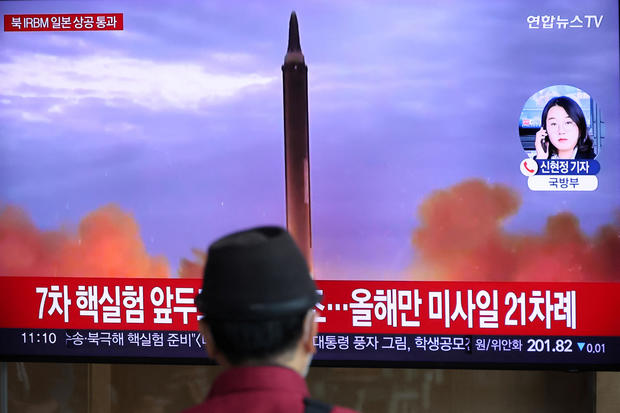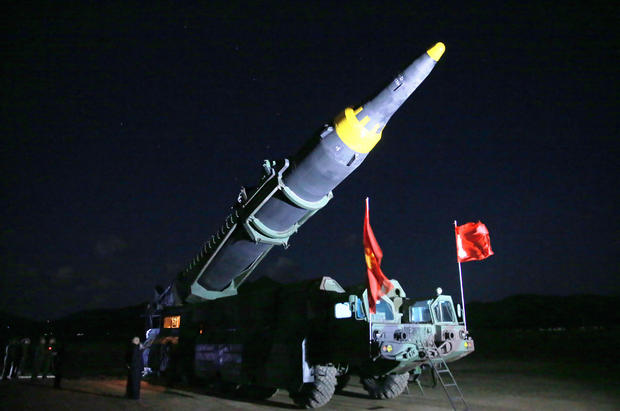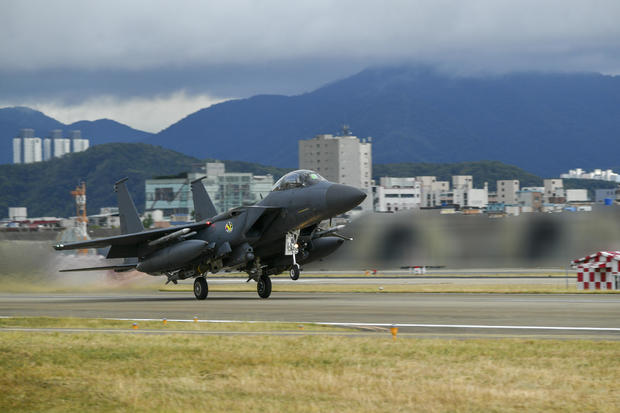North Korea fires ballistic missile over Japan for first time in 5 years, drawing quick response from U.S., South Korea
Seoul, South Korea — North Korea on Tuesday fired a ballistic missile over Japan for the first time in five years, forcing Japan to issue evacuation notices and suspend trains during the flight of the nuclear-capable weapon that could reach the U.S. territory of Guam, and possibly beyond. The launch was the most provocative weapons demonstration by North Korea this year.
CBS News senior foreign correspondent Elizabeth Palmer reported from Tokyo that residents of coastal communities in northern Japan were woken up Tuesday by sirens and warnings to prepare to evacuate their homes.
North Korea fired the missile from near its border with China. It took took 22 minutes to fly 2,800 miles on a path directly over northern Japan before crashing into the sea. Analysts believe the missile was the Hwasong-12, which the Kim regime rolled out in a military parade in January.
The test of the apparent Hwasong-12 appeared to be North Korea's longest-range missile launch to date, and would put major U.S. military bases in the region easily within range.
The U.S. and South Korea conducted a "combined attack squadron flight and precision bombing drill in response to North Korea's intermediate-range ballistic missile provocation today," the South Korean Joint Chiefs of Defense said in a statement later Tuesday.
The drill saw four South Korean F-15s and four U.S. F-16 fighter jets fire two shots at a set target, which the South Korean military said had demonstrated the will by both countries "to respond resolutely to any provocation from North Korea, the ability to precisely strike the origin of the provocation with the overwhelming power of the alliance, and a readiness posture for retaliation."
Later, on Tuesday night, South Korea and the U.S. also conducted a live-fire drill. However, a South Korean ballistic missile malfunctioned and fell on land during the drill, with sound of the blast and subsequent fire triggering panic among residents in the coastal city of Gangneung.
South Korea's Joint Chiefs of Staff said Wednesday that no one was hurt from the Tuesday night accident. It said the military was investigating why the Hyunmoo-2 missile malfunctioned. It didn't immediately specify where the missile landed.
The military acknowledged the accident hours after internet users posted videos showing an orange ball of flames emerging from an area they described as near a Gangneung air force base.
The Joint Chiefs of Staff said the South Korean and U.S. militaries successfully fired a total of four Army Tactical Missile Systems missiles during the exercise that it said was aimed at demonstrating its precision strike capabilities against the North.
As Palmer reported, Tuesday's was the latest and most threatening test in what has already been a bumper year of 23 separate missile launches by North Korea. The last time the North fired a rocket over Japan, however, was 2017, when North-South relations hit a low point just before then-President Trump's attempts to negotiate directly with Kim.
There was no immediate comment from the Kim regime about Tuesday's test, but Palmer said the North Korean dictator's message was clear: He's angered and threatened by the growing military alliance in the Pacific between the U.S. and its key partners South Korea and Japan.
Palmer noted that there have been no recent signs that negotiations — even indirect talks — are under consideration to defuse the tension.
Japan's Prime Minister Fumio Kishida condemned the "reckless act" and quickly convened his country's National Security Council. The United States also strongly condemned North Korea's "dangerous and reckless decision" to launch what it described as a "long-range ballistic missile" over Japan.
U.S. Secretary of State Anthony Blinken held separate calls with his Japanese and South Korean counterparts and, the State Department said, all three "strongly condemned the launch and its blatant disregard of multiple U.N. Security Council resolutions and its deeply destabilizing implications for the region."
"The United States will continue its efforts to limit (North Korea's) ability to advance its prohibited ballistic missile and weapons of mass destruction programs, including with allies and U.N. partners," National Security Council spokesperson Adrienne Watson said in a statement.
Japanese authorities alerted residents in northeastern regions to evacuate to shelters, in the first "J-alert" since 2017 when North Korea fired an intermediate-range Hwasong-12 missile twice over Japan in a span of weeks during its previous torrid run of weapons tests.
Trains were suspended in the Hokkaido and Aomori regions until the government issued a subsequent notice that the North Korean missile appeared to have landed in the Pacific. In Sapporo city, the prefectural capital of Japan's northernmost main island of Hokkaido, subways were also temporarily suspended, with stations packed with morning commuters.
According to South Korean and Japanese estimates, the missile traveled about 2,800-2,860 miles at a maximum altitude of 600-620 miles. Hamada said it landed in the Pacific, about 1,990 miles off the northern Japanese coast and that there were no reports of damage to Japanese aircraft or ships.
South Korea's Defense Ministry said the missile flew farther than any other weapon fired by North Korea. Before Tuesday's launch, the 2,300 mile-long flight of Hwasong-12 in 2017 was North Korea's longest. It has previously tested intercontinental ballistic missiles at steep angles so they flew shorter distances.
The missile's flight distance shows it has enough range to hit the U.S. Pacific territory of Guam, home to U.S. military bases that sent advanced warplanes to the Korean Peninsula in shows of force in past tensions with North Korea. In 2017, North Korea threatened to make "an enveloping fire" near Guam with Hwasong-12 missiles amid rising animosities with the then-Trump administration.
North Korea last test-fired a Hwasong-12 missile in January. At the time, the North said the launch was meant to verify the overall accuracy of the weapon, which it said was launched on a lofted angle to prevent it from flying over other countries.
CBS News' Jen Kwon in Seoul contributed to this report.


